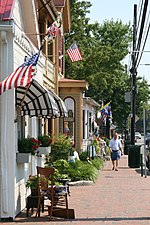Wittman, Maryland
Maryland populated places on the Chesapeake BayTalbot County, Maryland geography stubsUnincorporated communities in MarylandUnincorporated communities in Talbot County, MarylandUse mdy dates from July 2023
Wittman is an unincorporated community in Talbot County, Maryland, United States. Wittman is located at the intersection of Pot Pie Road, New Road, and Cummings Road south of Claiborne. Wittman has a post office, with the ZIP code 21676. The Flying Cloud was listed on the National Register of Historic Places in 1985.
Excerpt from the Wikipedia article Wittman, Maryland (License: CC BY-SA 3.0, Authors).Wittman, Maryland
Cummings Road,
Geographical coordinates (GPS) Address Nearby Places Show on map
Geographical coordinates (GPS)
| Latitude | Longitude |
|---|---|
| N 38.793611111111 ° | E -76.294166666667 ° |
Address
Cummings Road 8892
21676
Maryland, United States
Open on Google Maps


